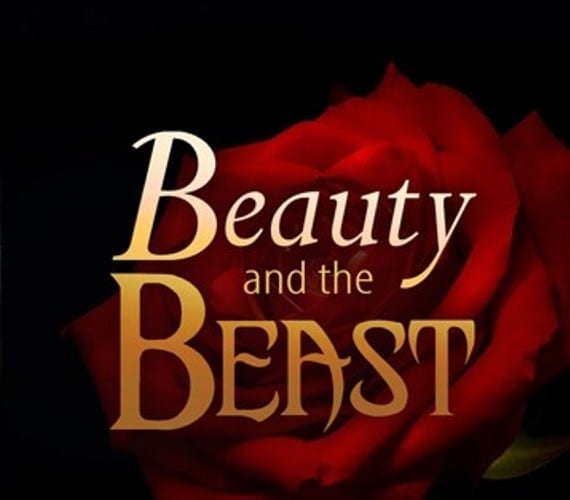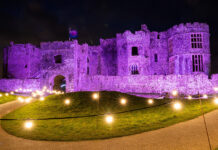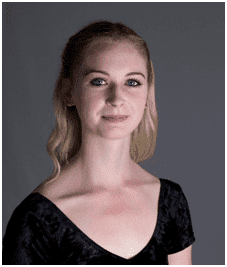 ERIN FLAHERTY, PRINCIPAL DANCER
ERIN FLAHERTY, PRINCIPAL DANCER
Q AND A
Who inspired you to take up ballet?
I started going to ballet classes at the age offour and soon found that I had a love for it. My ballet teacher was an inspirational woman and she nurtured and encouraged me to progress and consider it as a professional career as she had. My family have always encouraged me to pursue whatever makes me happy.
What do you enjoy the most about dancing “Beauty & the Beast”?
It was one of my favourite films growing up and I absolutely love that I get to see the story through the eyes of Beauty. I also think the costumes are stunning and it helps to bring the ballet to life.
How doesthe characterisation of roles within the ballet come about, are there elements of mime?
There is a really great story to tell throughout this ballet, so I am really excited about this. The emotions and interactions between the characters are usually told by both the movement quality and the music, however mime is also used to really clarify the story for the audience.
How do you relax away from the stage whilst on tour?
I really enjoy walking around and exploring the different venue areas in which we perform.
Is there a ballet role you would really love to dance?
The two iconic roles I always wanted to perform were the Sugar Plum Fairy from The Nutcracker and Odette from Swan Lake. I was incredibly fortunate to perform as the Sugar Plum Fairy last Christmas.
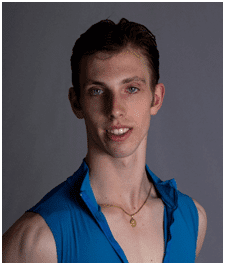 BEN CROSSLEY-PRITCHARD, PRINCIPAL DANCER Q AND A
BEN CROSSLEY-PRITCHARD, PRINCIPAL DANCER Q AND A
Who inspired you to take up ballet?
I started ballet after being placed in my first ballet class at nine years old but one of my earliest inspirations that I can recall came from watching old videos of the great Rudolf Nureyev dancing Basilio in the ballet Don Quixote.
What do you enjoy the most about dancing “Beauty & the Beast”?
One of my favourite parts about performing such a variety of different characters is learning how to overcome the challenges that come with each role.
I also enjoy the development process with each of the characters and getting the chance to adapt a role and make it my own.
How does the characterisation of roles within the ballet come about, are there elements of mime?
I think with a role like Beast there is more emphasis on the use of the body and movement quality as a way of expression. With most roles you can use facial expressions to portray emotions and feelings. However, when the face is concealed by a mask a dancer can’t use facial expression as much, so you need to show more through the way the body moves and the movement quality.
How do you relax away from the stage whilst on tour?
When I’m away on tour I love to get out walking and exploring the different towns and cities we visit to experience the various shops and restaurants they have to offer.
If we don’t have a lot of time before a show then I will often relax backstage with some quiet music.
Is there a ballet role you would really love to dance?
There are several different roles that I would love to perform during my career such as James from the ballet La Sylphide and Franz from Coppélia. While I would love to perform these roles one day, one role that I would particularly love to dance is that of Albrecht from the ballet Giselle. It’s a role danced by many famous dancers and is something that I would love to get the opportunity to perform in the future.
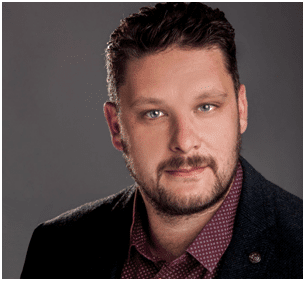 INTERVIEW WITH FOUNDER, ARTISTIC DIRECTOR AND CHOREOGRAPHER OF BALLET THEATRE UK, CHRISTOPHER MOORE.
INTERVIEW WITH FOUNDER, ARTISTIC DIRECTOR AND CHOREOGRAPHER OF BALLET THEATRE UK, CHRISTOPHER MOORE.
Q: Can you tell us a little bit about Ballet Theatre UK and how you came to found it?
‘Ballet Theatre UK is a ballet company that aims to provide the highest quality of classical dance to regional venues throughout the UK. We have created 14 full length ballets over the past decade. This included the classics such as Swan Lake, The Nutcracker and The Sleeping Beauty, as well as original ballets like The Snow Queen, The Little Mermaid and Beauty and the Beast. Throughout my dance career I noticed a gap in the industry for high quality ballet in theatres unable to host the larger companies such as the Royal Ballet, therefore wanted to deliver a production with the same standard adapted to suit the variety of theatres in the UK who would otherwise receive the classical art form.’
Q: Ballet Theatre UK has been described as ‘innovative’. Why is that exactly?
‘I’ve taken traditional ballets, which to some people have become museum pieces, bringing them up-to-date for the modern audience and engaging our audiences with a passion and energy that I hope is inspiring. The dancers bring much to the company making me able to create choreography which best shows their techniques.’
Q: What inspires you when you are creating a new ballet or choosing a new repertoire?
‘I’ve taken inspiration from an eclectic mix of classical dance, theatre, popular culture and literature to create new interpretations of popular classical ballets and I hope to continue to develop new and original productions in the future in the same way.
Q: For how long do the dancers train for a new work?
‘We rehearse for six weeks intensively to create each new ballet. Rehearsals continue once the production is on tour to ensure the work is always presented at its best. Work continues on the nuances of the production, honing and perfecting the delivery of the show’
Q: How many people work behind the scenes on a production, and what kind of things do they do?
‘We have a Ballet Mistress, who is responsible for the daily class the dancers undertake and the wellbeing of the dancers; a Technical Manager who ensures the show is installed in each theatre and is ready to roll out on time every night; a Tour Manager who organizes, amongst other things, cast accommodation and their transportation to each venue; Wardrobe and Admin staff. Their roles are varied and very important to the smooth running of the company’.
Q: Who will be dancing the lead roles during the tour?
‘We are lucky enough to have several leading dancers within the company from many established companies from around the world. This season the title role of ‘Beauty’ will be danced by principal dancers Erin Flaherty and Anna Yliaho and the ‘Beast’ by ‘Ben Crossley-Pritchard and Oliver Cooper.
Q: On tour, you have to constantly adapt to different theatres and stages. How long do you get to prepare and practice at a new venue?
‘We generally know what to expect at each theatre – the stage size, space in the wings etc. The technical team usually arrives early morning and the dancers follow during the morning. Before each show, the dancers take a warm-up class then a show run through is undertaken after the technical installation is complete. Depending on travel distances it can be only a few hours to install the show and be ready to perform’
Q: For those who have never watched ballet, how would you persuade them to come along?
‘I had a retired gentleman approach me after one of our shows who said that he had never been to a ballet before and was so pleased he had now done so, having enjoyed it immensely. I think it should be considered as one of life’s experiences; you’ll never know till you try it. A live show with a high visual content and rousing music will always set the heart beating faster! Romeo and Juliet is a perfect introduction as it is such a well-known story yet the complex choreography challenges the seasoned classical ballet fan.’
Help keep news FREE for our readers
Supporting your local community newspaper/online news outlet is crucial now more than ever. If you believe in independent journalism, then consider making a valuable contribution by making a one-time or monthly donation. We operate in rural areas where providing unbiased news can be challenging. Read More About Supporting The West Wales Chronicle

















